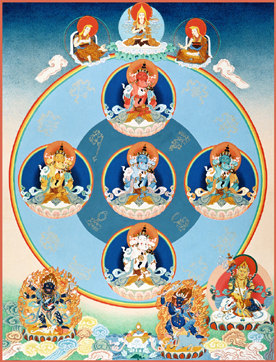The Five Buddha Families

 The 'five Buddha families' is a Vajrayana Buddhist conceptual framework for understanding the energies that pervade our minds and world, and how these energies can be expressed in either enlightened or unenlightened form. It is used in Buddhist tantric teachings, and the five Buddhas associated with this system are often depicted in Tibetan mandalas such as the one shown here, as well as Shingon Buddhist artwork.
The 'five Buddha families' is a Vajrayana Buddhist conceptual framework for understanding the energies that pervade our minds and world, and how these energies can be expressed in either enlightened or unenlightened form. It is used in Buddhist tantric teachings, and the five Buddhas associated with this system are often depicted in Tibetan mandalas such as the one shown here, as well as Shingon Buddhist artwork.Each of the five energies commonly has an element, color, and Buddha associated with it, and often a dakini or season as well. When each energy is expressed in its purest, most natural form, it manifests as an aspect of enlightenment. When expressed in neurotic, egoic form, it manifests as an aspect of ignorant, or unenlightened, existence. The enlightened forms are often also referred to as the five qualities of the Buddha or the 'Five Wisdom Buddhas'.'
These five energies are constantly in play within our awareness and the world. The goal of Tantric spiritual practice is to transform these energies within our own awareness from their unenlightened into their enlightened aspect. No energy is considered intrinsically 'bad', and so the focus is not on self-judgment or ridding ourselves of negative traits. Instead the focus is on recognizing the energy underlying any trait we find problematic or feel brings us suffering, and working to transform it into its purest expression.
Although most of us manifest each of these energies at different times, we usually associate more closely with one or two of the families. Therefore the five Buddha families can also be used as a tool for understanding our psychological framework, as they are most commonly represented in Tibetan Buddhism:
Below is a brief description of each family:
Buddha Family
Element: Space
Color: White
Buddha: Vairocana
Enlightened Aspect: Wisdom of All-Encompassing Space
In its enlightened aspect, Buddha energy expresses itself as open and spacious, while in its neurotic state it is dull and ignorant. In unenlightened form, it may manifest in a person's awareness as a heaviness, laziness, or lack of interest in intellectual pursuits. When transformed into its enlightened form, it manifests as warmth, keenness, and openness.
Vajra (Diamond) Family
Element: Water
Color: Blue
Buddha: Akshobya
Enlightened Aspect: Mirror-Like Wisdom
In its enlightened aspect, Vajra energy expresses itself as clarity and true insight, while in its neurotic state it is fearful, controlling and overly conceptual. In unenlightened form, it may manifest in a person's awareness as aggression, or as the need to over-analyze as a way of avoiding fear and real emotion. When transformed into its enlightened form, intellect becomes a sharp tool for insight and a true understanding of the nature of reality.
Ratna (Jewel) Family
Element: Earth
Color: Yellow
Buddha: Ratnasambhava
Enlightened Aspect: Equanimity
In its enlightened aspect, Ratna energy is expansive and inclusive, enriching everything and everyone it touches, while in its unenlightened form, it manifests as pride, greediness and materialism. In unenlightened form, it may manifest in the desire to accumulate both possessions and attention, or as a domineering tendency. When transformed into its enlightened form, Ratna energy regards all existence with equanimity, and expands out to enrich its surroundings.
Padma (Lotus) Family
Element: Fire
Color: Red
Buddha: Amitabha
Enlightened Aspect: Discriminating-Awareness Wisdom
In its enlightened aspect, Padma energy manifests as profound understanding and creative abilities capable of producing enlightened art, while in its unenlightened form it manifests as grasping desire. While Ratna energy may manifest in the accumulation of material things, Padma energy usually manifests in terms of seduction, or the seeking of pleasure at all costs. In its enlightened expression, an acute attention to detail and refined aesthetic sense becomes a tool for the creation of profound art.
Karma (Action) Family
Element: Wind
Color: Green
Buddha: Amogasiddi
Enlightened Aspect: All-Accomplishing Wisdom
In its enlightened aspect, Karma energy manifests as enlightened and compassionate activity that aids many beings, while in its unenlightened form it is frantic, impulsive, or jealous. Karma energy is always very active, and may manifest as a frenzied and aggressive attempt to control every aspect of a situation. In enlightened form this active tendency is transformed into dharmic service, organizing and creating structures and situations that bring greater enlightenment into the world.
For more information on the Five Buddha Families, see Irini Rockwell's The Five Wisdom Energies: A Buddhist Way of Understanding Personalities, Emotions, and Relationships.
You Should Also Read:
The Four Schools of Tibetan Buddhism
The Trikaya in Tibetan Buddhism
Vajrayana or Tantric Buddhism

Related Articles
Editor's Picks Articles
Top Ten Articles
Previous Features
Site Map
Follow @mommymystic
Tweet
Content copyright © 2023 by Lisa Erickson. All rights reserved.
This content was written by Lisa Erickson. If you wish to use this content in any manner, you need written permission. Contact Lisa Erickson for details.


